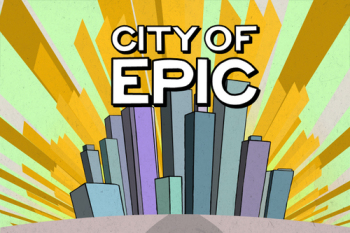I didn’t find out about the City of Epic Kickstarter campaign until about half an hour before it closed, or I would have mentioned it sooner. But it’s worth talking about and keeping an eye on even if you aren’t a donor.
“Gamification” has been a buzzword in interaction design for a couple of years now, inspired by the success of Foursquare and similar systems that give you points and badges for achievements. There’s some evidence that adding game-style features to behavior modification systems works; Gretchen Anderson has done some great work on how to think about these features as you build your system. But, like with 3D movies and bacon-flavored everything, there’s been a backlash: too many people have slapped badges and points onto otherwise undistinguished apps and hoped those tricks would rescue the experience, so now people new greet points systems with some understandable skepticism.
What I like about Kelly Maguire and Katherine Ramos’s take on games is that they are approaching it from the other direction. Having gotten started by competitively checking in at the gym on Foursquare, they understand the value of points systems, and where their impact starts to wane. So they decided to try to start from the other direction - create a good game, and layer real-world achievements into it. I am not sure whether this will be a harder or easier thing to do, but it certainly distinguishes them from the pack.
I have some confidence that they’ll be able to pull it off from having met Kelly Maguire through a close mutual friend. Kelly’s best-known project is the Tinysaur, a set of teeny tiny laser-cut make-your-own-dinosaur kits. Making the Tinysaur required technical skill, a creative vision, and most of all a sense of the value of delight for its own sake. A tinysaur is just a ridiculous thing, but you can’t help smiling at those photos. Delight is too often undervalued and underconsidered as a design element; the fact that City of Epic is already delightful (watch that Kickstarter video!) makes me very happy indeed.
Kelly is also the co-creator of the Indie Crafts Shows directory site, now five years old, which means she knows something about building for, and sustaining, a community as well, which will be a critical piece of the puzzle. I don’t think that the game will stay thrilling forever - games, like stories, have an end. But Katherine is right when she notes on the company blog that motivation and consistency are key factors to starting a workout routine. Giving people a reason to build that consistency in the early weeks and months, before they start seeing results, is something City of Epic could be great at. What it will need as it grows is a way for people who have built that consistency, who have that routine, to want to stay engaged. A MMPORG designer once told me that most of their subscribers, after a certain plateau of success, are just there to hang out with their friends; Katherine and Kelly will have to watch to see what the City of Epic equivalent of that is, and figure out how to design for the person who is happy going to the gym twice a week but doesn’t necessarily want to do more.
The Kickstarter campaign is over, and successful, and Kelly and Katherine are off working on the beta. But I am sure if you were to contact them about adding a late donation, they would be interested in talking further.
